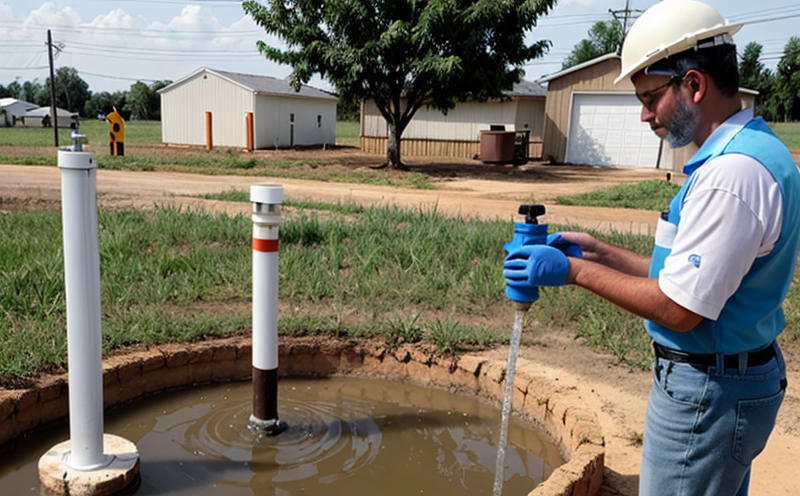ISO 10523 pH Measurement of Groundwater
The ISO 10523 standard provides a method for measuring the pH of groundwater, which is essential for ensuring water quality compliance and safeguarding public health. This test is critical in various sectors such as environmental protection, agriculture, and urban planning. Understanding the pH level helps identify potential risks associated with acidic or alkaline conditions that could affect soil fertility, aquatic ecosystems, and drinking water supplies.
The ISO 10523 method employs a combination of sample collection techniques and analytical instruments to achieve precise measurements. It specifies the use of specific equipment like glass electrodes, reference electrodes, and temperature compensation devices to ensure accurate readings. The standard also outlines procedures for handling samples to minimize contamination and improve measurement accuracy.
The pH scale ranges from 0 to 14, with values below 7 indicating acidity and above 7 indicating alkalinity. Groundwater pH can vary widely depending on the geology of the region and natural processes like weathering. For instance, acidic groundwater might be a concern in areas rich in volcanic ash or certain types of rock formations. Conversely, alkaline conditions could arise from high concentrations of carbonate minerals.
The importance of accurate pH measurement cannot be overstated. Deviations from optimal levels can lead to various issues. In agriculture, for example, overly acidic soil may inhibit plant growth and reduce crop yields. Similarly, in urban settings, improper water pH could cause corrosion in plumbing systems or affect the taste and odor of treated drinking water.
Compliance with ISO 10523 ensures that groundwater is safe for its intended use, whether it's irrigation, industrial processing, or potable consumption. By adhering to this standard, laboratories can provide reliable data that support informed decision-making by stakeholders across different industries.
The procedure described in ISO 10523 involves several key steps: collecting representative samples from the ground, preparing them according to specified protocols, calibrating instruments accurately before use, and conducting measurements under controlled conditions. Each step is crucial for obtaining accurate results that reflect true groundwater pH levels.
- Sample collection should be done at depths appropriate for capturing representative groundwater without contamination from surface sources.
- Precise calibration of electrodes before each use ensures consistent and repeatable measurements.
- Temperature compensation is vital because temperature affects the electrical properties of water, influencing pH readings.
Industry Applications
The ISO 10523 pH Measurement of Groundwater service finds application in numerous sectors where groundwater quality is paramount. Environmental protection agencies rely on this testing to monitor compliance with regulations and maintain ecological balance. Agricultural enterprises use the results to optimize irrigation practices, enhancing crop productivity while minimizing environmental impact.
In industrial settings, accurate pH data helps prevent costly equipment failures due to corrosion caused by acidic or alkaline conditions in water supply lines. Furthermore, municipalities employ this testing during water treatment processes to ensure treated water meets safety standards before distribution to consumers.
The insights gained from ISO 10523 pH measurements contribute significantly to sustainable development goals by promoting responsible resource management and protecting natural resources. By adhering to international standards like ISO 10523, organizations demonstrate their commitment to quality assurance and regulatory compliance.
International Acceptance and Recognition
The ISO 10523 standard is widely recognized across the globe for its robust methodologies in measuring groundwater pH. Its acceptance stems from rigorous validation against diverse environmental conditions, ensuring consistency and reliability worldwide.
This standard has been adopted by regulatory bodies such as the U.S. Environmental Protection Agency (EPA), European Union directives, and various national standards organizations. Compliance with ISO 10523 adds credibility to testing results, facilitating international trade and collaboration between countries sharing groundwater resources.
International acceptance also means that laboratories certified to perform these tests can operate seamlessly across borders, adhering to universally recognized practices. This interoperability fosters global cooperation in addressing water quality challenges, thereby promoting a healthier planet for all inhabitants.
Competitive Advantage and Market Impact
- Providing ISO 10523 pH Measurement of Groundwater services positions organizations as leaders in environmental stewardship, attracting clients who prioritize sustainability and ethical business practices.
- The ability to offer accurate and reliable testing results enhances brand reputation among industry peers, fostering trust and loyalty from customers.
- Organizations specializing in this service can differentiate themselves by offering comprehensive analytical packages that include other critical water quality parameters, such as dissolved oxygen content or heavy metal concentrations.
- A strong track record of compliance with international standards like ISO 10523 contributes to market leadership and opens up opportunities for expansion into new regions seeking reliable testing services.
By leveraging these competitive advantages, businesses can secure a larger share of the market, especially in sectors heavily regulated by environmental laws or those directly impacting public health. The demand for ISO 10523 pH Measurement of Groundwater will continue to grow as awareness about water quality issues increases globally.





